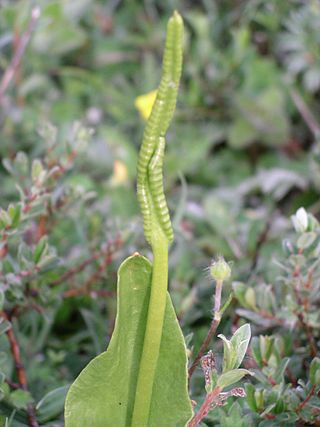
Ophioglossum, the adder's-tongue ferns, is a genus of about 50 species of ferns in the family Ophioglossaceae. The name Ophioglossum comes from the Greek meaning "snake-tongue". Their cosmopolitan distribution is mainly in tropical and subtropical habitats.

Cassia is a genus of flowering plants in the legume family, Fabaceae, and the subfamily Caesalpinioideae. Species are known commonly as cassias. The genus includes 37 species and has a pantropical distribution. Species of the genera Senna and Chamaecrista were previously included in Cassia. Cassia now generally includes the largest species of the legume subtribe Cassiinae, usually mid-sized to tall trees.
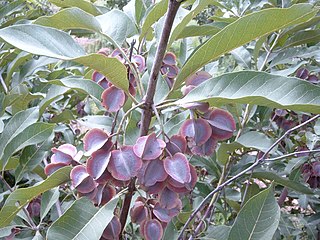
Combretum, the bushwillows or combretums, make up the type genus of the family Combretaceae. The genus comprises about 272 species of trees and shrubs, most of which are native to tropical and southern Africa, about 5 to Madagascar, but there are others that are native to tropical Asia, New Guinea and the Bismarck Archipelago, Australia, and tropical America. Though somewhat reminiscent of willows (Salix) in their habitus, they are not particularly close relatives of these.

Sesbania is a genus of flowering plants in the pea family, Fabaceae, and the only genus found in tribe Sesbanieae. Riverhemp is a common name for plants in this genus. Notable species include the rattlebox, spiny sesbania, and Sesbania sesban, which is used in cooking. Plants of this genus, some of which are aquatic, can be used in alley cropping to increase the soil's nitrogen content. The species of rhizobia responsible for nitrogen fixation in Sesbania rostrata is Azorhizobium caulinodans.

Entandrophragma is a genus of eleven known species of deciduous trees in the family Meliaceae.

Chrysobalanaceae is a family of flowering plants, consisting of trees and shrubs in 27 genera and about 700 species of pantropical distribution with a centre of diversity in the Amazon. Some of the species contain silica in their bodies for rigidity and so the mesophyll often has sclerenchymatous idioblasts. The widespread species Chrysobalanus icaco produces a plum-like fruit and the plant is commonly known as the coco plum.
Angoseseli is a genus of flowering plants in the family Apiaceae. Its only species is Angoseseli mossamedensis.
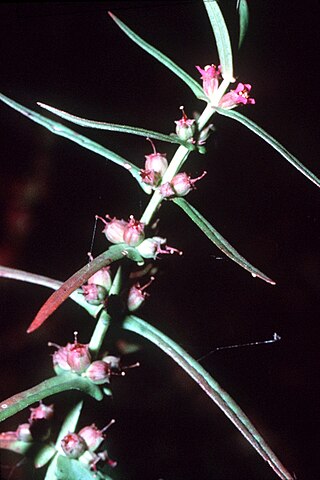
Ammannia is a genus of around 100 species of plants often referred to as redstems from wet areas in America, Africa, Asia, Australia and Europe. Several species are grown as decorative plants in aquariums.

Aganope is a genus of flowering plants in the family Fabaceae. It belongs to the subfamily Faboideae. The genus contains 11 species, which range across sub-Saharan Africa, south and southeast Asia, and New Guinea.

Physostigma is a genus of flowering plants in the family Fabaceae. It includes five species of erect or climbing herbs and subshrubs native to sub-Saharan Africa. They grow in tropical swamp and riverine vegetation and seasonally-dry forest, open woodland, and grassland in the Guineo-Congolian and Zambezian regions. The genus belongs to subfamily Faboideae.

Platysepalum is a genus of flowering plants in the family Fabaceae. It includes 13 species of small trees, shrubs, or lianas native to tropical Africa, from Senegal to Tanzania and south to Angola and Mozambique. Most species are native to the Guineo-Congolian forests of west and west-central Africa, and one is native to the tropical Zanzibar-Inhambane coastal forests of Africa's eastern coast. Habitats include tropical rain forest and seasonally-dry lowland forests, often in disturbed areas. It belongs to subfamily Faboideae.

Corynanthe is a genus of flowering plants in the family Rubiaceae.
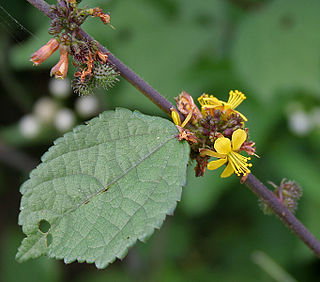
Triumfetta is a genus of plants in the family Malvaceae. Burbark is a common name for plants in this genus.
Pycnanthus is a genus of flowering plants in the nutmeg family, Myristicaceae. There are 4 species, all native to tropical Africa. Some species are lianescent, an unusual feature in this family which is otherwise composed of hardwood trees.
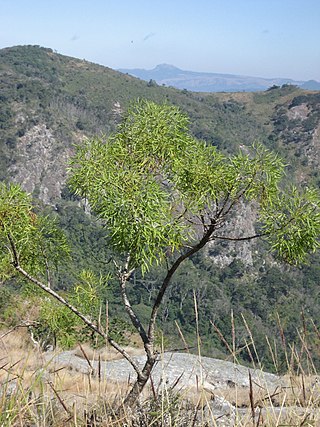
Heteromorpha is a genus of plants within the family Apiaceae. Its species are native to southern and tropical Africa and the southwestern Arabian Peninsula.
Octolobus is a genus of tropical forest trees in the family Malvaceae, subfamily Sterculioideae. They are found in Central and West Africa and are closely related to the genus Cola.
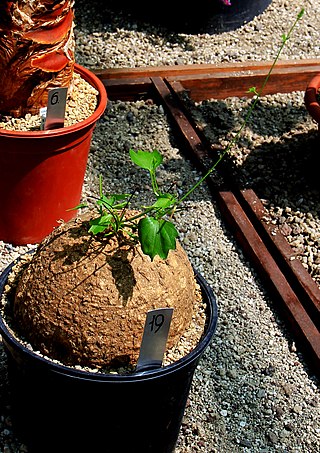
Trochomeria is a genus of flowering plants belonging to the family Cucurbitaceae.
Campylostemon is a genus of flowering plants belonging to the family Celastraceae.
Physotrichia is a genus of flowering plants belonging to the family Apiaceae.













